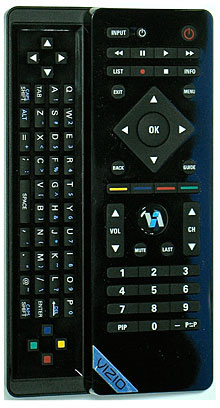Vizio XVT553SV LCD HDTV Page 2
An Adaptive Luma control, which appears to operate somewhat like a dynamic contrast control, offers four active settings, plus Off. More on this a bit further on. There’s also a PIP and POP feature with the usual limitations (you can’t view two HDMI sources at once, for example).
 Smart Dimming is Vizio’s name for the set’s LED local dimming. The XVT553SV’s LEDs are arrayed in 120 zones behind the LCD panel. Smart Dimming darkens these zones independently as required by the source, from completely black to 100 percent full white, providing a dramatic improvement in the mediocre black levels typical of LCD displays. Vizio’s dynamic (peak, or full-on/full-off) contrast ratio claims are as fanciful as those of most other manufacturers (in this case, the specification is 10,000,000:1!). Nevertheless, LED local dimming is a major advance in LCD displays.
Smart Dimming is Vizio’s name for the set’s LED local dimming. The XVT553SV’s LEDs are arrayed in 120 zones behind the LCD panel. Smart Dimming darkens these zones independently as required by the source, from completely black to 100 percent full white, providing a dramatic improvement in the mediocre black levels typical of LCD displays. Vizio’s dynamic (peak, or full-on/full-off) contrast ratio claims are as fanciful as those of most other manufacturers (in this case, the specification is 10,000,000:1!). Nevertheless, LED local dimming is a major advance in LCD displays.
On-Line
With a wired or wireless link to your home network, you can access a wide range of Vizio Internet Apps (VIA) including Netflix, Vudu, Flickr, and more. You can stream on-demand movies and TV shows, participate in social networking, link up to news, weather, and sports sites, or listen to music and view photos. As of early October, however, YouTube was not yet among the VIA offerings.
Our testing studio’s Internet connectivity tops out at a less-than-blazing 3 Mbps or so, which is not enough bandwidth to get the best performance from streaming features like Netflix and Vudu. We’re looking into getting that bumped up so we can get the kind of performance we know Vudu in particular is capable of delivering.
Vizio provides a limited range of picture controls for the Internet features, but at least you can turn down the searingly bright default settings with the Backlight control. The set can also download and automatically install Vizio firmware updates.
High Performance
Apart from 2:2 HD, the Vizio’s video processing ranged from very good to excellent, with particularly fine performance on the motion adaptive test, where it showed no jaggies at all on the pattern’s rotating bar.
Out of the box, the Vizio’s picture needed work. The dark end was crushed by a too-low Brightness setting (presumably to impress potential buyers with the set’s deep, dark blacks), and Smooth Motion was engaged along with a gaggle of other Advanced controls.
I switched to Movie mode, then turned off all of the Advanced Picture features except Film Mode (left in Auto) and Smart Dimming. I dialed back Color to 39, Sharpness to 6, and perhaps most nonintuitively, Backlight to 3 (the maximum is 100). Then I increased the backlight to 51. This was only a marginal increase from the default setting, but it improved the performance of Smart Dimming.
Now I was getting somewhere. While the color seemed a little off its tea (I’ve been watching a lot of Alice in Wonderland lately), the resolution was outstanding. Sulley’s fur in Monsters, Inc. never looked furrier, and Jack Sparrow’s scruffy, craggy facial features in Pirates of the Caribbean: The Curse of the Black Pearl have never looked scruffier or craggier.
While most viewers will likely be happy with the XVT553SV’s color out of the box, it took a good calibration to really dial it in. I first fiddled with the suspiciously named Color Enhancement control. While its effects were generally subtle, it produced the most accurate color gamut when turned off. Subsequent gray-scale calibration produced superb results (see HT Labs Measures). Alice in Wonderland is loaded with both bright and subtle colors, and the Vizio rendered them all beautifully. With some material, I felt that the set’s color looked a little pale (which I prefer to overcooked) when dialed in using test patterns and a blue filter. But using color filters to set color and tint correctly can be dicey at best, particularly with LCD sets. This set doesn’t have a blue-only mode, which would aid in dialing in a more technically precise setting of these controls.
The benefits of local dimming were less dramatic here than on other local-dimming sets we’ve tested. To be fair, though, those sets invariably cost far more. Like them, the Vizio’s local dimming could sometimes drop the black level to total darkness. And also, like them, it generated faint halos around bright white objects against black backgrounds. But unlike those pricier models, bright objects, even when they occupied a small portion of an otherwise black image often raised the overall black level of the Vizio’s entire screen (such as the rotating circle of dots that accompanies data loading at the beginning of many Blu-ray Discs). Nevertheless, even those raised black levels, as measured, were lower than the black levels you’re likely to find in any competitively priced set.




























































